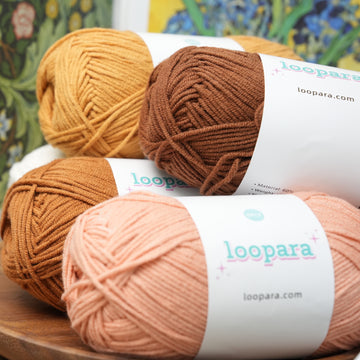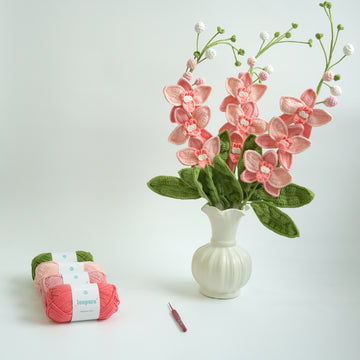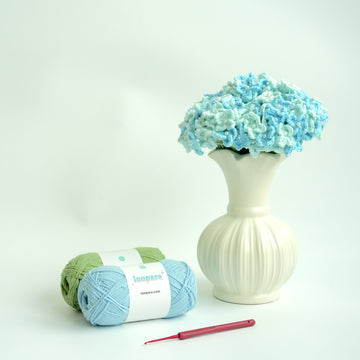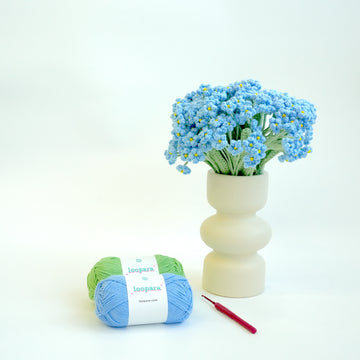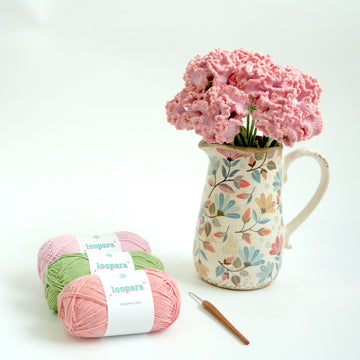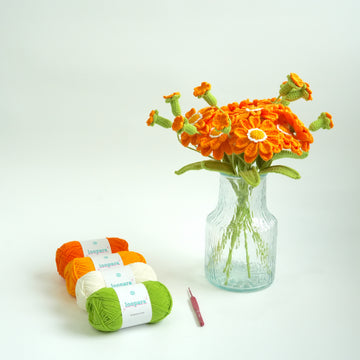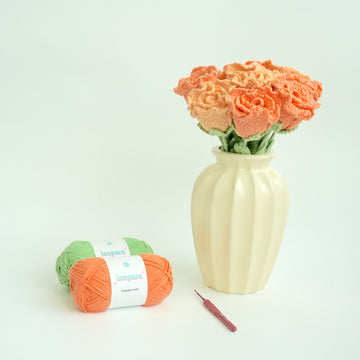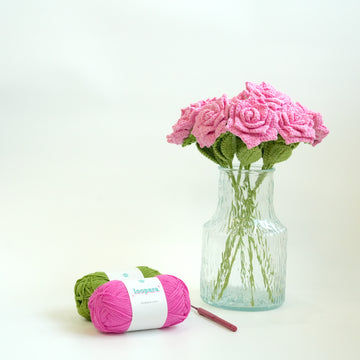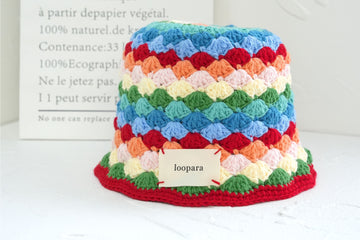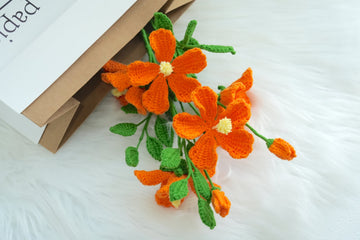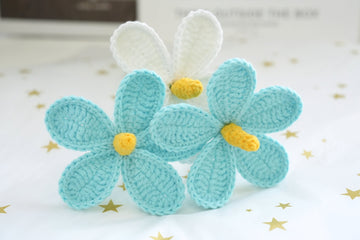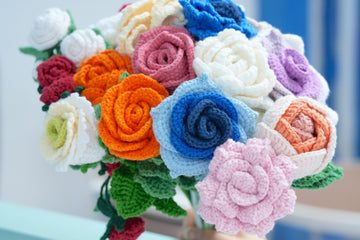Both cotton and acrylic yarn are popular choices for crocheting. But which is better?
We’re going to look at cotton vs acrylic yarn across a range of different criteria. Spoiler alert: we think there’s a clear winner!
Read on to find our verdict …
What makes a better yarn?
Different projects require yarns with different properties. A lace doily, for example, will need a delicate thread, while you’d choose a heavier yarn for chunky knitwear.
Lots of people will draw the conclusion that the answer to whether cotton or acrylic is better depends on the project. But for once, we think it’s simpler than that.
To compare cotton and acrylic, we’re going to assess them against a range of different criteria:
- Versatility
- Stitch definition
- Ease of use
- Washability
- Allergens
- Affordability
- Environmental credentials
But if you don’t want to get into all the detail, here’s a quick answer. If your top priority is a tight budget, choose acrylic. If you’re prepared to spend slightly more, cotton is almost always the winner.
1. Cotton vs. Acrylic Yarn - Versatility
Both cotton and acrylic are versatile yarns. They come in a range of weights, with different yarns suitable for everything from delicate jewellery to snuggly blankets.
And you can find both cotton and acrylic yarns in a whole rainbow of colors. So whatever your project, you should be able to find an option in either fiber to meet your needs.
There is one small caveat to this. If you want to buy your yarn in person, not every area will have the same selection. In some places, you might find a wider range of acrylic than cotton yarns. But if you’re happy to buy online, you’ll be spoilt for choice either way.
If you want to dye your own yarn, though, acrylic is a no-no. It’s basically a form of plastic made from petrochemicals, so the fibers are very smooth. That means there’s nothing for the dye to cling to.
You can buy dyes that are specially formulated for acrylic yarns, but they still tend to come out looking faded.
If you want to dye yarn a bespoke shade, choose cotton. And for stronger, faster color, mercerised cotton is better still. It’s softer than standard cotton too, but it is more expensive.
2. Cotton vs. Acrylic Yarn - Stitch definition

Buy Loopara 4-ply Milk Cotton Yarn
Clearly defined stitches generally make for more attractive articles. That’s particularly the case if you’re doing fine work, or using color or a three-dimensional pattern like cabling. And when it comes to stitch definition, cotton yarns are superior to acrylic.
That’s because they have limited elasticity, so the stitch stays tight. Acrylic yarn, on the other hand, will give you stitches with a fluffier appearance.
3. Cotton vs. Acrylic Yarn - Ease of use
It’s difficult to say precisely how easy a particular type of yarn is to use. That will depend on your own preferences and crocheting style.
Some people report finding acrylic more challenging to work with than cotton. Some acrylic yarns, especially cheaper ones, can be scratchy and tough on the hands.
Cotton yarn varies too, with some types tougher than others. In general, though, cotton is softer and more malleable.
Mercerised cotton is smoother and more comfortable to worth with. But it can be slippery on your crochet hook. Some people prefer using a wooden hook when crocheting with this type of yarn.
Acrylic, on the other hand, has a spongier texture which stays on the hook more easily.
So when it comes to ease of use, there’s no clear winner. Cotton is generally easier on the hands. Acrylic is generally easier to keep on the hook.
4. Cotton vs. Acrylic Yarn - Washability

Buy Loopara 5-ply Milk Cotton Yarn
If you search online, you’ll find many people saying acrylic is more “washable” than cotton. But it’s not quite as simple as that.
There’s no argument that items made from acrylic yarn can go into the washing machine. And you won’t have to worry about them felting or shrinking if you put wash them on a warmer cycle.
Cotton, on the other hand, can shrink if you wash it too hot. And depending on the type of cotton, colors may run or fade on a hot wash too.
But does that really mean acrylic is more washable? We say, “No”. But why?
Because the problems with washing cotton are really only problems if you select too hot a wash. Items made from cotton yarn can emerge unscathed from the washing machine at most temperatures.
With acrylic yarn, though, washing in the machine at any temperature damages the fabric. And it has some serious environmental consequences too.
Wash acrylic too hot, and it will pill – in other words, produce those unattractive little balls on the surface of the fabric. It might not shrink, but it generally doesn’t wear well. Colors fade and the integrity of the fabric declines.
Washing also degrades the coating put on “hypoallergenic” acrylic yarn (more on that later). And with every wash, the yarn will leach microplastics – toxic to both humans and the environment.
To cut to the chase: cotton yarns are no more of a problem when it comes to laundry than anything else. Super-hot washes are a problem for most textiles, including acrylic. So if you’re chucking in a load of washing without sorting it, just don’t turn the dial too high.
As for creasing, there’s no denying that cotton can crease. The way that stitches are formed in crocheted items, however, makes visible creasing less of a problem. And cotton usually softens, the more it’s washed.
Acrylic creases too, but the creases are less noticeable. If you want to iron it, though, take care. The fibers melt under high temperatures. What this means in practice is that the fabric will become floppy and shiny.
5. Cotton vs. Acrylic Yarn - Allergens
We all want to know that the fabrics we’re using are safe. And with an increasing number of people reporting allergies, yarn labels that read “hypoallergenic” can be very reassuring.
You won’t often see this term on the labels of cotton yarn. That’s because it’s a plant-based product that hasn’t been treated to be hypoallergenic.
That doesn’t mean it will never cause a problem for someone with sensitive skin, though. Dyes, bleaches and processing methods can introduce toxins that cause skin irritation.
To minimise the risk of this, you’d need to use plant-based yarns (cotton, linen, bamboo etc) that hadn’t been dyed or bleached, and with the least possible processing.
Acrylic fiber, on the other hand, is made from a petroleum-based substance called polyacrylonitrile. It’s basically a form of spun plastic. When it’s turned into yarn, it’s given a special coating that acts as a barrier to dust mites and other allergens.
This coating can degrade over time, however.
And because acrylic fibers are so hard to color, they require special dyes known as disperse dyes. More people are allergic to disperse dyes than any other kind of dye.
Organic cotton yarn is a good option if you’re worried about allergens. Look for one certified by GOTS, the Global Organic Textile Standard.
If you want to use acrylic yarn, look for one that’s been certified by OEKO-TEX. This certifies that the yarn has passed tests for the presence of over 1,000 toxins.
6. Cotton vs. Acrylic Yarn - Affordability

Different yarns vary significantly in price. The same goes for yarns of the same fiber. Whether you choose cotton or acrylic, you’ll pay more for a higher quality yarn.
But when it comes to comparing the two fibers, cotton is almost invariably more expensive. And the difference in cost can be significant, especially if you’re working on a bigger project like a blanket.
It’s worth noting that most online yarn suppliers have regular sales. So if you plan ahead, you can often benefit from discounts on your chosen yarn.
7. Cotton vs. Acrylic Yarn - Environmental credentials
Cotton is a natural fiber, while acrylic comes from fossil fuels. But that doesn’t mean cotton is all good. And these days, not all acrylic is all bad, either.
Cotton requires warm temperatures and lots of water to grow. That means it’s a big draw on water resources, including in places where water is scarce. And because it can only thrive in certain areas, it’s often exported over long distances, requiring more fossil fuels for transportation.
Much of it is produced using large quantities of pesticides too. And the mercerising process used for some cotton requires yet more chemicals and energy.
Organic cotton is a better choice for the environment because no pesticides are used in its production. And if it’s dyed, the dyes will be organic too.
Acrylic yarn is produced from petrochemicals. The production process requires further energy. And every time it’s washed, it releases harmful microplastics into the environment.
But nowadays it’s possible to find acrylic yarn that’s been made from recycled plastics. The recycling process, of course, requires energy too. And those microplastics are just as much of a problem with this type of yarn. It does, though, prevent plastics from going into landfill.
Acrylic vs cotton: the final analysis
At the end of the day, the “right” yarn is a personal choice. But we think cotton is the winner.
If you’re working on a budget, you’ll get more acrylic than cotton yarn for your money. But if you’re able to spend more, cotton has advantages in terms of stitch definition, dye-ability and washability.
And while organic cotton is pricier still, but it’s also kinder to the environment.


